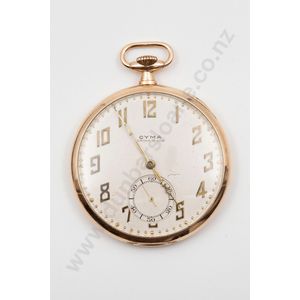
Collection of 18 Seiko, Cyma, Pro Trek GPS watches
Eighteen assorted wristwatches including Seiko, Cyma, and Pro Trek "Gps Navigation" watch.

14ct Yellow Gold Cyma Watch with Mechanical Wind Movement
Antique 14ct yellow gold Cyma watch mechanical wind movement working when tested, marked 585 14k. Approx case width 26 mm, estimated gold weight 1.2 grams, crack to the dial

Cyma 9ct Open Face Pocket Watch, Swiss Made
Original boxed Cyma 9ct open face lever wind pocket watch silvered satin finish dial with Arabic numerals 15 jewel Swiss mechanism

Vintage 9ct Rose Gold Cyma Watch with Tavannes Movement
Mid-century 9ct rose gold Cyma watch . Navy star with a Tavannes caliber R.459 17 jewel manual wind movement does run, there is no crown. Marked to the case only 9ct, weight 4.8 grams. Circa 1950s

Rose Gold Pocket Watch with White Dial and Arabic Numerals
9ct rose gold full hunter pocket watch white dial, with Arabic numerals and subsidiary seconds dial. Marked CYMA to dial. Stem wind. Stamped 375 & Hallmarks for Birmingham 1929. Glass loose. crack in case. 48 mm wide. Total weight 70gms.

1920's Cyma Pocket Watch with Yellow Gold Plating
A Cyma open faced pocket watch, yellow gold plated, circa 1920's, detailed by striped case, white enamel dial, Arabic numerals, case marked rolled gold SFC 676756/458 Swiss Cyma movement 15 jewels 285378,

Cyma 14ct Gold Chronometre Pocket Watch, Guilloche Cover
A Cyma 14ct gold open face pocket watch, white enamel dial, signed Chronometre, Arabic numerals, subsidiary seconds, stem wind and set 15 jewel movement with 3 adjustments, guilloche cover with vacant cartouche. Size 42 mm. Wt. 46.1g.

Cyma Art Deco Half Hunter Watch, 15 Jewels
Art Deco era Cyma rolled gold half hunter watch, with 15 jewels swiss movement, working when tested, 5.6 cm high

Cyma Rolled Gold Pocket Watch, 17 Jewels, 44.3mm Size
A Cyma rolled gold open face pocket watch, matte dial with applied baton markers subsidiary seconds on a 17 jewel stem wind and set movement. Size 44.3 mm

 Loading more...
Loading more...